
Fur Sales On The Rise
An Animal Rights Article from All-Creatures.org
FROM
Shimon Shuchat,
TheirTurn.net
July 2016
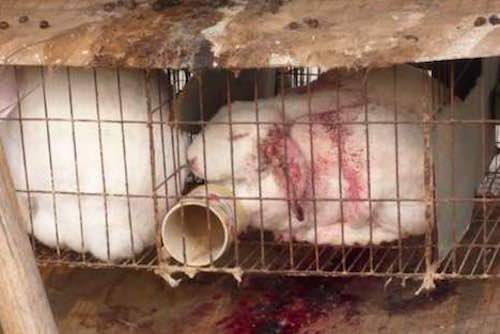
There is a perception in the animal rights community that fur consumption is declining when, in fact, it is on the rise.
- From 1990 – 2015, fur sales in the U.S. grew by approximately 50%
- From 2013 to 2014, U.S. fur sales grew by 7.3%
- In 2014, fur sales in the U.K. increased by 20%
- From 2011 – 2013, global fur sales jumped by more than 50% – from $16 billion to $36 billion
According to the Fur Information Council of America (FICA), the largest U.S. fur association, the number of designers who use fur has dramatically increased, climbing from 42 in 1985 to approximately 500 today. FICA also asserts that 55% of the people who buy fur today are under 44, dispelling the myth that fur is primarily consumed by older people.
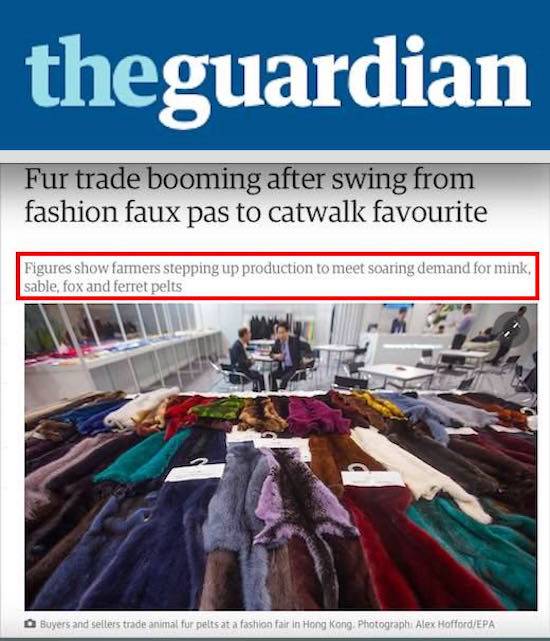
A 2015 article published in the Guardian documented the rise of
the fur industry.
“The fur industry’s statistics reflect what we’re seeing in the streets — that fur consumption is on the rise,” said Edita Birnkrant, Campaigns Director for Friends of Animals, an international animal advocacy group. “For the sake of the animals, we have to organize and take a more aggressive approach on their behalf.”
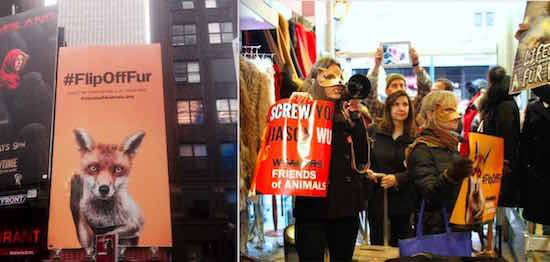
Friends of Animals holds in-store protests and puts up anti-fur
billboards.
The increase in fur sales can be attributed to many variables, including high demand from China; the use of technology to make fur suitable for warm climates; the growing use of fur trim; the increased use of fur in men’s clothing; the growing practice of dying fur; and the consumption of fur among celebrities with a large social media following. According to Mark Oaten, CEO of the International Fur Federation, “…with this increase in demand, farmers are deciding to invest more in fur farms and increase production.”
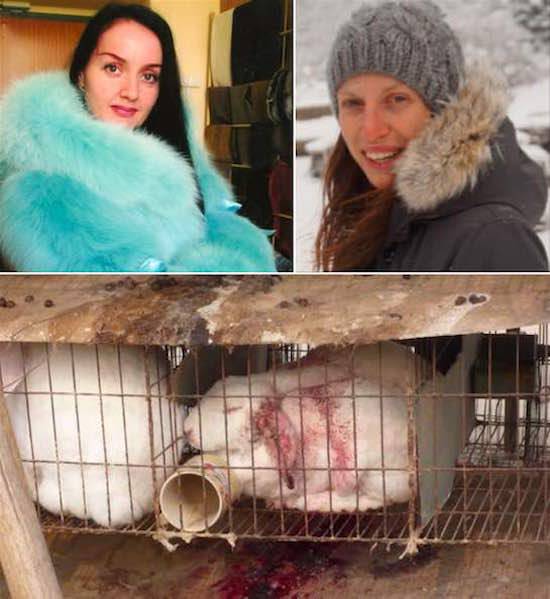
Dying fur and the growing use of fur trim have led to an increase in fur
sales and, by extension, the number of fur farms.
While the animal rights community appears to be losing the war against the fur trade (despite occasional victories), some activists have responded to the increased prevalence of fur by engaging in more provocative anti-fur tactics. During the past several winters, activists Robert Banks and Angela Dee from NYC, the nation’s fur capital (according to FICA), have posted videos on social media in which they publicly shame fur wearers. The videos, which also include graphic footage of animal cruelty in the fur industry, have garnered millions of views. “If people know that by wearing fur they are risking public humiliation, perhaps they will think twice before draping themselves in the skins of tortured and murdered animals,” said Robert Banks.
Many self-proclaimed animal rights activists have criticized their tactics, claiming that they are misogynistic. In response to this allegation, Angela Dee said “It is not our fault that most fur wearers are women. By this logic, shouldn’t protesting rape also be sexist since most rapists are men?”
One of their videos has made an especially large impact. It shows a trapped coyote being shot dead juxtaposed with the logo of Canada Goose, a Canadian manufacturer of luxury apparel that uses real coyote fur. After being promoted by PETA, the video, which was viewed over 16 million times on Facebook, triggered a Twitter campaign. Canada Goose took notice and responded with a Facebook post stating, “In response to the recent campaign from PETA, we know and deeply respect that whether or not people want to wear fur is a personal choice…We read and hear all of your feedback.” Canada Goose also claimed that its fur is “responsibly sourced.”
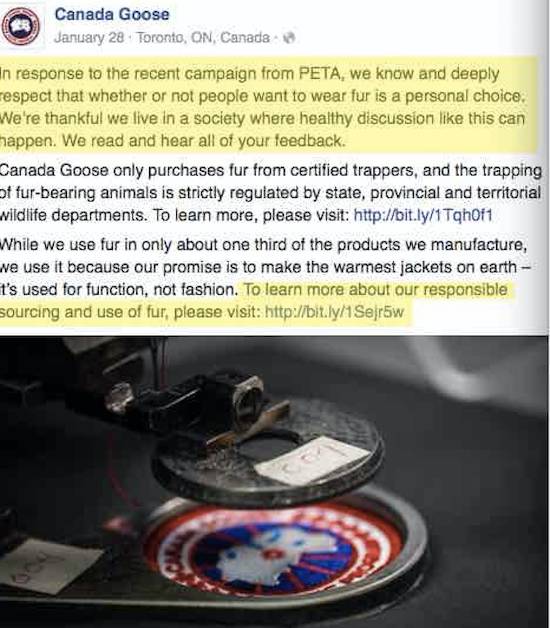
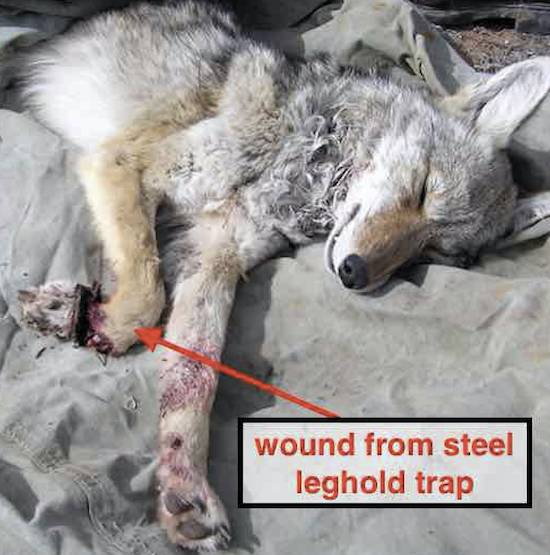
Canada Goose responded to the video and PETA's campaign with a Facebok
post...
According to Born Free USA, a national animal advocacy organization, over 50 million animals are killed every year by the fur industry across the globe. Fur farmed animals spend their lives in small cages where they go insane from the stress of confinement and rarely receive veterinary care. The animals are killed in ways that are inexpensive and that do the least damage to their pelts — gassing, anal/vaginal electrocution, neck braking, poisoning, or by bludgeoning them to death. Wild caught animals can suffer for days in painful traps and snares from exposure to the elements, hunger, and thirst before being shot or bludgeoned to death by a trapper. According to Born Free USA, the number of trappers in the U.S. has increased by 20% since 2004.
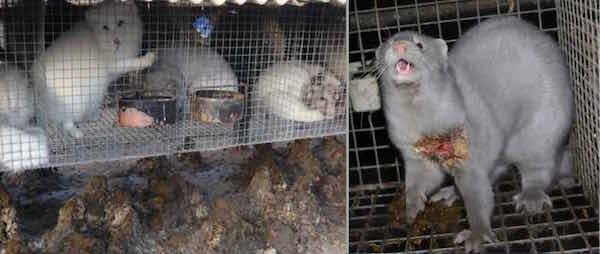
Fur farmed animals spend their lives in filthy, overcrowded cages and
rarely receive veterinary care.
Most fur comes from China where animal protection laws are virtually non-existent. PETA undercover investigations on Chinese fur farms have revealed animals being skinned alive. They have also shown that dogs and cats are kidnapped and sold into the fur trade.
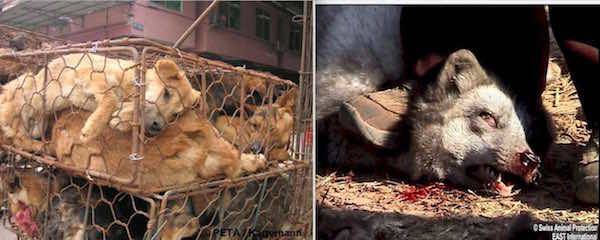
Investigations on Chinese fur farms have revealed horrific cruelty and
that dogs and cats are killed for their fur.
YOUR TURN:
- Keep apprised of legislation that affects the fur industry and take action at Born Free.
- To participate in anti-fur protests in your area please sign up to PETA’s action center.
- Contact your House representative and ask him/her to co-sponsor the “Public Safety and Wildlife Protection Act” which would “ban the import, export, and interstate commerce of both steel-jaw leghold traps and Conifer traps,” two of the cruelest devices used to capture fur-bearing animals.
- If you see someone wearing fur, film your encounter and post it on social media.
Return to Animal Rights Articles







